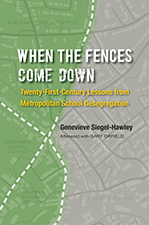These maps created by Genevieve Siegel-Hawley correspond to her book:
Siegel-Hawley, G. (2016). When the Fences Come Down: Twenty-First-Century Lessons from Metropolitan School Desegregation. Chapel Hill: UNC Press, ISBN 978-1-4696-2783-0.
Based on widely differing experiences with city-suburban school desegregation in Richmond, Virginia, Louisville, Kentucky, Charlotte, Mecklenburg, North Carolina, and Chattanooga, Tennessee between 1990 and 2010, the book relies on quantitative data and maps to both underscore the damages wrought by school district boundary lines and raise awareness about communities that have sought to counteract them. When the Fences Come Down shows that city-suburban school desegregation policy is related to clear-cut progress on both school and housing desegregation. In an era largely preoccupied with accountability and school choice, the book revisits educational policies that in many cases were abruptly halted—or never begun—to spur an open conversation about the creation of the healthy, integrated schools and communities critical to our multiracial future.
Previous versions and discussion of these maps have also appeared in:
Siegel-Hawley, G. (2013). “City Lines, County Lines, Color Lines: The Relationship between School and Housing Segregation in Four Metro Areas”, Teachers College Record, 115(6), 1-45.
Siegel-Hawley, G. (2014). “Mitigating Milliken? School District Boundary Lines and Desegregation Policy in Four Southern Metros, 1990-2010", American Journal of Education, 201(3), 391-433.













